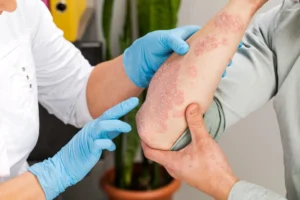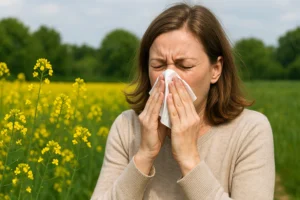Table of Contents
When you think of food allergies, you may think of itching and swelling of the tongue, throat, and airways, difficulty breathing, or needing to use an EpiPen to stop a life-threatening reaction. For many children, that is how food allergies appear, but for many others the response to food allergies may look different, even over time, and may not be immediately identified as a food allergy.
A different but difficult-to-manage manifestation of food allergies is skin-related problems such as itching, redness, swelling, rashes, raised bumps, flaking of skin, cracked skin, and skin infections resulting from damaged skin. One of the most common skin problems in food allergy is atopic dermatitis, a common type of eczema.
What is Eczema?
Eczema is an inflammatory skin condition that causes dry skin, itchiness, rashes, scaly patches, and blisters. Often, a parent or caregiver of a child with skin-related allergy problems has to practice an elimination diet which is a meal plan that removes certain foods over time with the goal of identifying what the child is allergic to. The parent or caregiver also must manage specialized and complicated skin care regimens to minimize uncomfortable skin symptoms.
Developing a thorough understanding of how food allergies affect the skin and learning key points in allergic skin care can help empower parents and make this challenge more manageable. Understanding how food allergies affect the skin, what happens to the skin when a child has eczema caused by food allergies, and how to manage and treat similar allergic skin conditions will make pediatric allergy management less daunting for affected children and their caregivers.
What is a Food Allergy?
In order to understand how food allergies might affect the skin, it is first important to understand the different ways that food allergies occur in the body. A food allergy is our immune system’s response to something our body considers dangerous. When an allergen is ingested, the immune system deploys a variety of components, including white blood cells and antibodies (called immunoglobulins), which leads to a range of mild-to-severe symptoms. The symptoms and the way they are effectively managed depend on which types of immune cells are involved in the allergic process.
What Causes a Typical Allergic Reaction?
The stereotypical “allergic reaction” most people think of involves antibodies called immunoglobulin E (IgE). These fast-acting antibodies respond within minutes of exposure to an allergen and the symptoms, ranging from mild to severe, usually consist of swelling and itching of the tongue and mouth, runny nose or watery eyes, increased heart rate, difficulty breathing, coughing, wheezing, vomiting, and sometimes even death.
Some children experience an allergic reaction that triggers more than one part of the immune system. This is known as a mixed IgE- and non-IgE-mediated food allergy. An example of this type of reaction is atopic dermatitis, or eczema, where the typical IgE is activated as well as other immune system components such as T helper 2 (TH2) cells which flood the area to destroy unwanted microbes and kill infected cells.
How are Eczema and Food Allergies Related?
There are mixed opinions about whether having eczema is a risk factor as well as precursor to developing food allergies, or if eczema is purely a response to food allergies; regardless, children with both eczema and food allergies experience an exacerbation of skin-related symptoms when they ingest a trigger food.
Chronic release of immune components in the presence of environmental irritants, paired with a weakening of the skin’s natural barrier, leads to inflamed, itchy, dry, and cracked skin that is more susceptible to bacterial infections. The most affected of the body include the hands, face, inner elbows, and knees. About 30% of children with moderate to severe eczema have associated food allergies. Although it is possible for any food to trigger an allergic response and eczema, the most common culprits are milk, eggs, wheat, soy, and peanuts.
How Does Food Sensitivity and Intolerance Affect the Skin?
Food intolerance or food sensitivity is a chemical reaction that some people experience from ingesting certain foods and drinks. Though not technically an allergy, food sensitivity or intolerance may also cause skin disruption even though they do not typically trigger an immune system reaction. Symptoms of food intolerances are often “dose-dependent,” meaning that small amounts of a food may not result in a “big” reaction, but larger quantities of food may cause more pronounced symptoms. Symptoms can also be delayed by several hours after exposure to the food for food intolerance unlike in true food allergies where the allergic reaction is immediate.
Most food intolerance, such as intolerance to milk and egg, usually causes gastrointestinal symptoms like nausea, vomiting, and diarrhea because of the body’s digestive system struggling to break down the food. Some foods, however, contain components or additives that can trigger a response from the vascular system (blood circulatory system) leading to increased blood flow, redness, flushing, feeling hot, and even hives. These symptoms do not involve the immune system (non-immune-mediated) and can occur on any part of the body; however, they mostly affect the face.
Common culprits of a non-immune-mediated response include amines (in aged or preserved foods), sulfites (in beer and wine), caffeine, fructose, aspartame, food dyes, and monosodium glutamate (MSG).
What is the Function of the Skin?
The skin is the largest organ in the body, and it has many roles. Properly functioning skin is often taken for granted, but the skin is a very complicated and delicately balanced system with multiple layers. The most superficial layer known as the epidermis varies in thickness throughout the body but is generally about 1.5mm at the thickest place. The epidermis provides a physical waterproof barrier for your body as well as contributes to skin tone. It also provides the first barrier of protection from foreign pathogens. Cells in the epidermis known as melanocytes produce melanin, our skin pigment.
Beneath the epidermis are two other major layers of the skin – the dermis which houses the blood vessels, nerves, and cellular components and is directly underneath the epidermis, and the subcutaneous fat which is the deepest layer and responsible for energy storage and maintenance of body heat.
The skin is also home to beneficial organisms, mostly bacteria, that prevent the growth of harmful pathogens. Some of these skin bacteria help the immune system fight infections. Lipids or oils produced and stored between the skin cells provide a moisturized and protective barrier against pathogens and allergens. New production and death of epidermal cells occur at a rapid rate with a complete turnover of old skin in approximately every 28 days.
Eczema and Food Allergies
Eczema is known as the “itch that rashes” because most people that suffer from eczema have dry skin which causes itching; the itching ultimately leads to a skin rash mostly present on the face and extremities. With chronic irritation, the skin will become thickened, tough, and discolored from frequent scratching. Eczema can lead to frequent skin infection and poor quality of life if not treated. Eczema is more commonly seen in children than adults.
In eczema, a combination of factors disrupts our delicately balanced skin barrier. Over or underproduction of certain skin components leads to an imbalance between proteins and lipids which allows excessive water to be lost, causing inflammation, and increases the risk of infection from unwanted bacteria such as Staphylococcus Aureus (S. aureus).
In children with food allergies, exposure to their food allergens can worsen skin inflammation by flooding the already irritated skin with IgE and other immune components. This leads to dry, itchy, cracked, dysfunctional skin that is easily irritated or infected. Sometimes the skin is rough with bumpy patches (often red or pink on pale skin), raw with oozing areas, and crusting. The skin around the eye may also be darkened. For people with brown or black skin, the redness may be less obvious or may look more like small, flesh-colored, raised, or rough bumps.
The initial rash and itching can appear within hours to days of ingesting an allergen, but the oozing, crusting, and skin thickening takes much longer to develop as children scratch at their skin and introduce harmful bacteria into the body. If infection does occur, the child may develop pustules or even bright red, painful, “scalded”-appearing skin.
Eczema is considered to be a risk factor for food allergy, and around 22% of children under the age of two and 16% of older children with food allergies experience eczema as a symptom of their allergy. Children who experience food allergies with eczema are also more likely to have other allergic disorders such as asthma. Parental history of eczema also increases the likelihood that a child will have eczema.
The most common food allergies in children are peanuts, milk, and tree nuts; however, for children experiencing eczema as a symptom of food allergy, sesame, soy, and wheat are the most common offenders. For children under two years old, wheat, soy, and eggs are most common.
Considerations for Skin Affected by Allergens
If your child is dealing with food-allergy-related skin problems, it can be helpful to understand how disruptions in skin cells, moisture, and bacteria can lead to problems. Prevention and prompt treatment of exacerbations is crucial as symptoms can quickly escalate. It is also important to learn how to prevent and treat symptoms as well as properly care for sensitive skin. Since the food reaction may not be immediate or life threatening, as is the case with anaphylaxis, it may feel like a child doesn’t really have to avoid an allergen completely or see an allergist right away; however, even though eczema is not life threatening, it can very easily impact the quality of life for a child and family, and every effort to minimize symptoms by avoiding the triggering food should be taken.
The first step in skin care for a child with food-allergy-related eczema is figuring out their common triggers, including food allergens. Just like children with other food reactions, a good pediatric allergist will help with a definite diagnosis as well as provide information on what foods to avoid.
One of the most common infant allergens is cow’s milk. If a baby is allergic to cow’s milk, they should be switched to safer options such as hydrolyzed or amino acid formula. Breastfeeding mothers of babies with cow’s milk allergies may need to adhere to a dairy-free diet since proteins from cow’s milk can pass into human breastmilk.
Some allergens, like milk or eggs, may be altered enough when baked at high temperatures that a child can consume baked products containing them, and thus, should just avoid eating those foods by themselves or uncooked. Other foods may cause a reaction even when cooked or when present in trace amounts, such as factory cross contamination. An experienced pediatric allergist will be able to tell you which forms of food to avoid based on your child’s unique situation.
Learning to read food labels is an important skill parents of children with allergies must learn, and children must be taught early on to ask about food ingredients when accepting food at school, playdates, parties, sporting events, camps, restaurants, and other social gatherings.
Non-Food Products and Skin Problems
Even non-food products such as soap, lotion, and fragrances containing an allergen can provoke an allergic reaction in your child. Some skincare products contain “natural” ingredients or fragrances to nourish and hydrate the skin. Such ingredients might include milk, eggs, avocado, cocoa or chocolate, coffee, soy, peach, honey, or many varieties of fruits or berries. While these products may look or smell appealing, and may even be effective for ensuring great skin, for someone allergic to one of the food ingredients, these products could cause a significant flare up of eczema or even lead to more serious reactions such as airway swelling or difficulty breathing. Reading labels on everything, not just food products, is an important part of daily life for people with allergies.
Exposure to a food allergen may trigger the immune system and start the inflammation process; however, many other irritants can exacerbate the process and further damage already dysfunctional skin. Examples of common irritants or triggers include heavily scented or perfumed cosmetics, cold and dry weather, humid and hot weather, tight or restrictive clothing, wool clothing, sweating, hormones, stress, infections, and frequent hand washing or bathing, especially with very hot water. These triggers are detrimental to anyone with eczema and can contribute to excessive drying of the skin and worsening irritation especially to areas of the skin with repetitive movements such as the wrists, elbows, knees, and ankles.
How to Take Care of Food Allergy Skin Problems
Thorough and consistent skin care, especially for an active or perhaps even resistant young child, can feel like a huge undertaking. But over time, the effort really does pay off and produce visible results as well as increased comfort for your child.
Your allergist may have different skin care routines for your child based on your child’s unique needs, skin type, and products readily available to you.
In general, to keep your child’s skin moisturized and clear from irritants, baths or showers should be taken with warm water, not hot, and limited to just 10 minutes a day. In the cold, dry months, even just showering every other day is a good idea to avoid excessively drying the skin. Very young children with eczema are particularly susceptible to drying out and you do not necessarily need to use soap with every shower. If you do want to use soap for hygiene reasons, choose one free of dyes, alcohol, fragrance, or antibacterial ingredients. Wash the skin gently with a washcloth and avoid scrubbing. Do not use rough towels and pat gently dry. Moisturize while the skin is still damp and within three minutes of exiting the bath. This is known as “soak and smear” and helps seal in the natural moisture before it evaporates. An appropriate moisturizer or lotion should also be free of dyes and fragrance.
For problem areas, plain Vaseline or other ointments recommended by your pediatric allergist may be particularly beneficial for sealing in needed moisture. You should moisturize your child’s skin at least twice a day and apply more frequently during flare ups or around problem areas.
Again, finding an experienced allergist near you, or even having a dermatologist on your child’s healthcare team is necessary to manage flare ups and possible infections that might arise from broken skin being exposed to bacteria. In addition to daily care like avoiding triggers, bathing, and moisturizing, treatment with steroid creams may be needed. In the case of an infection, treatment with topical or oral antibiotics may be needed. Also, keep your child’s fingernails short to discourage them from breaking their skin while scratching their skin and causing infection. An oral antihistamine may be helpful for children experiencing a lot of itching and can help reduce the urge to scratch.
Sometimes, in severe cases of eczema, your pediatric allergists may recommend adding a small amount of 5% household bleach to your child’s bath (¼ cup of bleach to a 40-gallon bathtub full of water) to reduce itching and chances of secondary infection. However, a bleach bath seems to be as effective as a simple water bath alone. If this is an option, it will normally be done under the care, direction, and supervision of your allergist or healthcare provider. There is some emerging evidence that oral immunotherapy (OIT), which is a way to desensitize people to foods they are allergic to by giving them small amounts of the food daily and building up their body’s resistance to the foods, can help reduce the symptoms of food-allergy-related eczema, though this may not be helpful for everyone.
While you may not immediately think of skin-related problems like eczema as a symptom of food allergy, if your child is living with this reality, you need as much information as you can to help manage this unique type of food reaction.
Talking with your child’s pediatric allergist to better understand their triggers and what foods and products to avoid is a great place to start. Since most children with eczema and other skin-related food allergy problems often get flare ups, you want to partner with an allergist such as a virtual-first allergy team that is readily available to help with flare ups.
An individualized skin care plan focused on restoring and maintaining moisture is also a necessary step in protecting dysfunctional skin and reducing eczema symptoms. Additional medications or treatments may be prescribed by your pediatric allergist with the goal of improving your child’s overall quality of life. Luckily, as many children eventually outgrow their food allergies, the accompanying eczema should disappear with it.











